Mini-ITX board sports AMD G-Series processors
Jan 25, 2011 — by LinuxDevices Staff — from the LinuxDevices Archive — 11 viewsBCM announced a Mini-ITX board based on AMD's recently announced, embedded-specific G-Series processors. The IX55AE offers speeds up to 1.6GHz, five SATA 3.0 ports, dual display capabilities, plus expansion slots for PCI Express x4 Gen. 2, Mini PCI Express, and CFast (the SATA-based CompactFlash variant), the company says.
AMD's "Fusion" line of APUs ("accelerated processing units") incorporates multicore x86 CPUs and DirectX 11-capable GPUs (graphics processing units) on a single die. The embedded-specific G-Series offerings announced last week range from 1.0GHz to 1.6GHz, provide adept multimedia performance, and occupy up to 60 percent less space than Intel's Atom chipsets, the chipmaker says.
We've already covered three devices employing G-Series CPUs: CompuLab's fit-PC3 mini-PC, Congatec's Conga-BAF COM Express module, and Sintrones Technology's VBOX-3200. Now, BCM — which recently announced Mini-ITX boards using both 2010 and 2011 versions of Intel's Core CPUs — has added a G-Series motherboard to its product line as well.
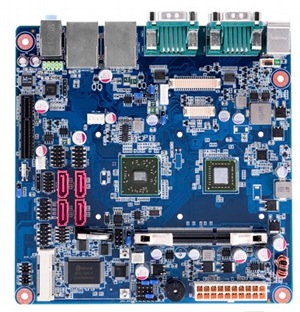
BCM's IX55AE
(Click to enlarge)
According to BCM, its IX55AE (above) will be offered with four of the five G-Series processors listed in the table below: the T56N, T48N, T40N, and T44R. The company apparently didn't see the point of the T52R, which has only a single core but an 18-Watt TDP, and frankly, neither do we.
| Model | Clock speed | Cores | Graphics | TDP max |
| T56N | 1.6GHz | 2 | HD6310 | 18W |
| T48N | 1.4GHz | 2 | HD6310 | 18W |
| T40N | 1.0GHz | 2 | HD6250 | 9W |
| T52R | 1.5GHz | 1 | HD6310 | 18W |
| T44R | 1.2GHz | 1 | HD6250 | 9W |
AMD's embedded G-series processors
The IX55AE uses AMD's A55E I/O controller — see later in this story for background — and accepts up to 4GB of DDR3 RAM in a single SODIMM slot, according to BCM. The motherboard leverages the G-Series APU's graphical capabilities by providing both VGA and HDMI ports on its coastline, plus internal headers for eDP (embedded DisplayPort) and LVDS, says the company.
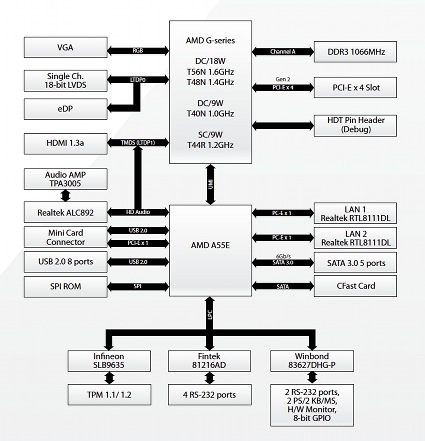
A block diagram of BCM's IX55AE
(Click to enlarge)
Citing dual display capabilities, BCM explains that the T56N and T48N include AMD's Radeon HD 6310 graphics, which allows resolutions up to 2560 x 1600 pixels. The T40N and T44R, on the other hand, include Radeon HD 6250 graphics, which BCM says support resolutions only up to a lower 1920 x 1200 pixels.
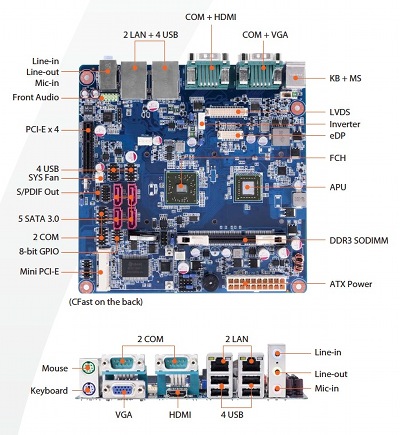
Details of the IX55AE's interfaces
(Click to enlarge)
Other I/O on the IX55AE's coastline (above) includes PS/2 ports for keyboard and mouse, two RS232 ports, two gigabit Ethernet ports (Realtek RTL8111DL), four USB 2.0 ports, and audio (mic in, line in, line out), according to BCM. Internal connectors include five SATA 3.0 ports (6 Gb/sec.), four more USB ports, two additional serial ports, an S/PDIF output, and digital I/O (four in, four out), the company adds.
BCM says the IX55AAE also has three expansion slots: one PCI Express x4 Gen. 2, one Mini PCI Express, and one for CFast (the SATA-based CompactFlash variant). The board is available with an optional Infineon SLB9635 TPM (trusted platform module), according to the company.
Features and specifications listed by BCM for the IX55AE include:
- Processor:
- AMD T56N clocked at 1.6GHz, with dual cores and 18 Watt TDP
- AMD T48N clocked at 1.4GHz, with dual cores and 18 Watt TDP
- AMD T40N, clocked at 1.0GHz, with dual cores and 9 Watt TDP
- AMD T44R, clocked at 1.2GHz, with single core and 9 Watt TDP
- Chipset — AMD A55E
- Memory — up to 4GB of DDR3 RAM via single SODIMM slot
- Expansion:
- 1 x Mini PCI Express slot
- 1 x PCI Express x4 slot
- 1 x CFast slot
- Networking — 2 x gigabit Ethernet
- Other I/O:
- External:
- 2 x PS/2
- 1 x VGA
- 1 x HDMI
- 2 x RS232
- 4 x USB 2.0
- audio — mic in, line in, line out
- Internal:
- 1 x LVDS
- 1 x eDP
- 4 x USB 2.0
- 2 x RS232
- 5 x SATA
- DIO (4 in, 4 out)
- External:
- Power requirements — AT/ATX
- Operating temperature — 32 to 140 deg. F
- Dimensions — 6.7 x 6.7 inches
- Weight — 0.96 pounds
Background
AMD's Fusion devices all incorporate the x86 CPU core codenamed "Bobcat." Illustrated below, this features an out-of-order execution engine — which breaks data apart and allows for instructions to run in parallel — plus clock and power gating that can extend battery life, according to the company.
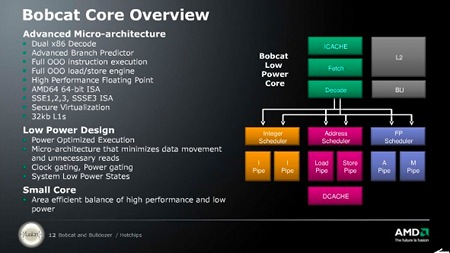
AMD's Bobcat
(Click to enlarge)
According to AMD, its "2011 mainstream platform" — to be available by the middle of this year — will feature the A-series "Llano" processor, including up to four Bobcat cores. This will deliver performance of more than 500 gigaflops, says the chipmaker.
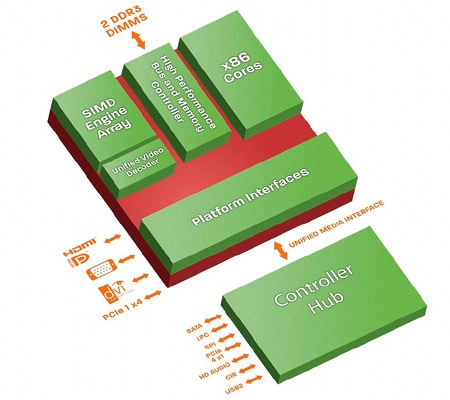
AMD's 2011 low power platform
(Click to enlarge)
The first implementation of Bobcat, however, is the "2011 low power platform" (formerly codenamed "Brazos" for the mobile version and "e-Brazos" in the embedded version) pictured above. When it announced the four mobile APUs listed below, AMD said the E-series chips would be for mainstream notebooks, all-in-one computers, and small form factor desktops, while the C-series would be for "HD netbooks and other emerging form factors."
| Model | CPU Cores |
CPU Clock Speed | Number of GPU Cores | GPU clock Speed | TDP |
| AMD E-350 | 2 | 1.6GHz | 80 | 500MHz | 18W |
| AMD E-240 | 1 | 1.5GHz | 80 | 500MHz | 18W |
| AMD C-50 | 2 | 1.0GHz | 80 | 280MHz | 9W |
| AMD C-30 | 1 | 1.2GHz | 80 | 280MHz | 9W |
AMD's E-series and C-series processors
The G-Series processors listed earlier in this story are pretty similar to the E-Series and C-Series, though there's a new "halfway house" 1.4GHz option. All feature 64KB of L1 cache, plus 512KB of L2 cache per processor core, according to AMD. They're designed to work with DDR3 memory, except for the T40N, which instead employs LVDDR3, the company adds.
According to AMD, each G-series device offers 4×1 or 1×4 PCI Express lanes on the APU, six SATA ports (6Gbps), 14 USB 2.0 ports, HD audio, plus SPI, LPC, and SMBus interfaces. One of two pin-compatible, "Hudson" I/O controllers may be employed, the company adds: either the A50M (also used by the E-series and C-series) or the new, embedded-specific A55E.
AMD says the A55E provides added functionality including a gigabit Ethernet MAC, RAID (0/1/5/10) support with FIS (frame information structure)-based switching, and a 32-bit PCI interface. The A55E also is said to use PCI Express Gen 2 for its UMI (unified media interface) connection to the G-series APU, presumably offering a dollop of extra speed thereby.
Further information
According to BCM, which did not offer pricing or operating system support details, the IX55AE is guaranteed to be on the market until 2018. More information may be found on the IX55AE product page.
This article was originally published on LinuxDevices.com and has been donated to the open source community by QuinStreet Inc. Please visit LinuxToday.com for up-to-date news and articles about Linux and open source.